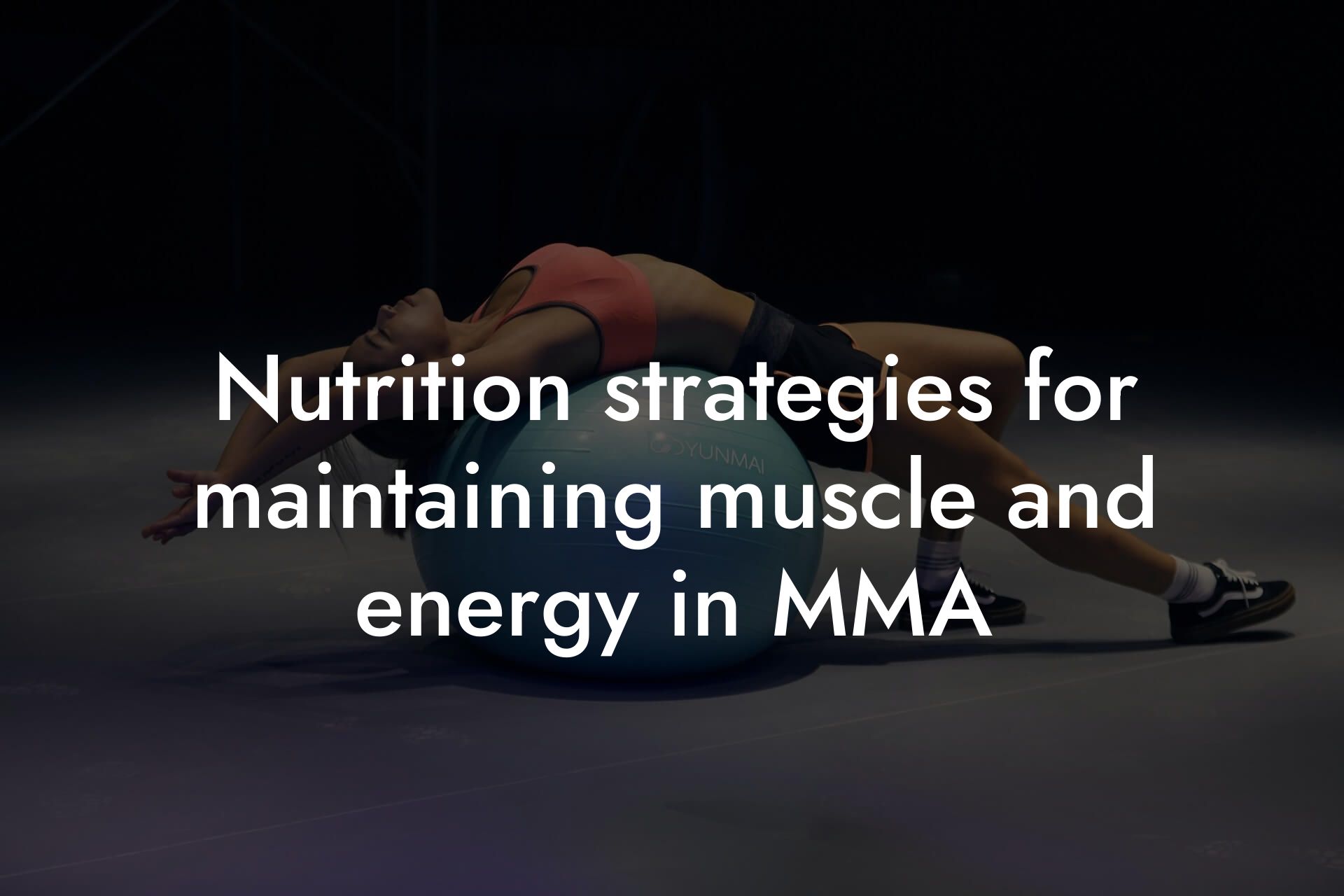As an MMA fighter, having a well-structured strength and conditioning program is crucial to achieving success in the octagon. A comprehensive program can help improve performance, increase endurance, and reduce the risk of injury. At Tano Performance Group, we understand the importance of physical appearance, body fat, physique, and bone density for high-earning professionals, and we're committed to providing you with the information you need to take your training to the next level. In this article, we'll delve into the world of strength and conditioning programs specifically designed for MMA fighters, exploring the key components, benefits, and considerations to help you optimize your training.
Table of Contents
- Understanding the Demands of MMA
- Key Components of a Strength and Conditioning Program for MMA Fighters
- Benefits of a Strength and Conditioning Program for MMA Fighters
- Considerations for MMA Fighters
- Incorporating DEXA Scanning into Your Strength and Conditioning Program
- Final Thoughts
- Frequently Asked Questions
Understanding the Demands of MMA
Mixed Martial Arts is a highly demanding sport that requires a unique combination of strength, power, speed, agility, endurance, and technique. MMA fighters need to be able to withstand the physical demands of a fight, which can include intense bursts of energy, prolonged periods of activity, and rapid changes of direction. A strength and conditioning program for MMA fighters must be tailored to meet these specific demands, focusing on exercises and drills that improve functional strength, power, and endurance.
Key Components of a Strength and Conditioning Program for MMA Fighters
A comprehensive strength and conditioning program for MMA fighters should include a combination of the following components:
Strength Training: A focus on building functional strength through exercises such as squats, deadlifts, bench press, and rows. This will help improve overall strength, power, and endurance.
Power Training: Incorporating explosive exercises like box jumps, depth jumps, and medicine ball throws to improve power and speed.
Conditioning: High-intensity interval training (HIIT) and endurance exercises like running, jumping rope, and bag work to improve cardiovascular endurance and increase stamina.
Flexibility and Mobility: Incorporating stretching and mobility exercises to improve range of motion, reduce injury risk, and enhance overall athleticism.
Core Training: Strengthening the core muscles through exercises like planks, Russian twists, and leg raises to improve stability, balance, and overall athleticism.
Benefits of a Strength and Conditioning Program for MMA Fighters
A well-structured strength and conditioning program can have a significant impact on an MMA fighter's performance and overall career. Some of the key benefits include:
Improved Performance: Increased strength, power, and endurance can lead to improved performance in the octagon, giving fighters a competitive edge.
Injury Prevention: A strength and conditioning program can help reduce the risk of injury by improving flexibility, mobility, and overall athleticism.
Enhanced Recovery: A comprehensive program can aid in recovery between fights and training sessions, allowing fighters to train more frequently and at a higher intensity.
Increased Confidence: A well-structured program can help fighters feel more confident and prepared, leading to improved mental toughness and focus.
Considerations for MMA Fighters
When developing a strength and conditioning program for MMA fighters, there are several key considerations to keep in mind:
Periodization: A program should be periodized to allow for peaks and troughs in training intensity and volume, ensuring fighters are fresh and prepared for competition.
Specificity: A program should be specific to the demands of MMA, incorporating exercises and drills that mimic the movements and actions of a fight.
Individualization: A program should be tailored to the individual fighter's needs, goals, and limitations, taking into account factors like age, experience, and injury history.
Progressive Overload: A program should incorporate progressive overload, gradually increasing intensity and volume over time to continue challenging the fighter and promoting adaptation.
Incorporating DEXA Scanning into Your Strength and Conditioning Program
At Tano Performance Group, we understand the importance of having a complete picture of your body composition and physiology. Our DEXA scanning technology provides a comprehensive assessment of body fat, muscle mass, bone density, and other key metrics. By incorporating DEXA scanning into your strength and conditioning program, you can:
Track Progress: Monitor changes in body composition and physiology over time, ensuring your program is effective and making adjustments as needed.
Identify Imbalances: Detect potential imbalances in muscle mass, bone density, and body fat, allowing you to target specific areas for improvement.
Optimize Nutrition: Use DEXA scan data to inform your nutrition plan, ensuring you're fueling your body for optimal performance and recovery.
A well-structured strength and conditioning program is essential for MMA fighters looking to optimize their performance and achieve success in the octagon. By incorporating a combination of strength training, power training, conditioning, flexibility and mobility exercises, core training, and DEXA scanning, fighters can improve their overall athleticism, reduce the risk of injury, and enhance their recovery. At Tano Performance Group, we're committed to providing high-earning professionals with the information and tools they need to take their training to the next level. By following the principles outlined in this article, you can develop a comprehensive strength and conditioning program that helps you achieve your goals and dominate in the world of MMA.
Final Thoughts
Remember, a strength and conditioning program for MMA fighters is not a one-size-fits-all solution. It's essential to work with a qualified coach or trainer who can help you develop a program tailored to your specific needs and goals. By combining a comprehensive strength and conditioning program with regular DEXA scanning, you can gain a competitive edge, optimize your performance, and achieve success in the world of MMA.
Frequently Asked Questions
What is the importance of strength and conditioning for MMA fighters?
Strength and conditioning are crucial for MMA fighters as they improve overall performance, increase endurance, and enhance recovery. A well-structured program helps fighters develop the power, speed, agility, and stamina needed to dominate in the ring or cage.
What are the key components of a strength and conditioning program for MMA fighters?
A comprehensive program should include a combination of strength training, conditioning exercises, plyometrics, agility drills, and flexibility exercises. It's essential to tailor the program to the individual fighter's needs, goals, and fighting style.
How often should MMA fighters train for strength and conditioning?
The frequency of training depends on the fighter's experience, goals, and upcoming competitions. Typically, a fighter should aim to train 3-4 times per week, with at least one day of rest in between. As the fight approaches, the intensity and frequency of training may increase.
What are the benefits of strength training for MMA fighters?
Strength training helps MMA fighters develop explosive power, increase their strength-to-weight ratio, and enhance their overall athleticism. It also improves bone density, reducing the risk of injuries and fractures.
What types of exercises are best for MMA fighters?
MMA fighters benefit from a variety of exercises, including squats, deadlifts, bench press, rows, and lunges. These exercises improve overall strength, power, and endurance. Additionally, plyometric exercises like box jumps and burpees are excellent for developing explosive power.
How can MMA fighters improve their conditioning?
Conditioning exercises like high-intensity interval training (HIIT), pro agility shuttle runs, and battle ropes are effective for improving cardiovascular endurance, increasing anaerobic capacity, and enhancing muscular endurance.
What is the role of flexibility and mobility in MMA training?
Flexibility and mobility exercises are crucial for MMA fighters as they improve range of motion, reduce the risk of injury, and enhance overall performance. Incorporating exercises like yoga, Pilates, or dynamic stretching can help improve flexibility and mobility.
How can MMA fighters incorporate plyometrics into their training?
Plyometric exercises like box jumps, depth jumps, and burpees are excellent for developing explosive power. Fighters should start with lower intensities and progress gradually to avoid injury. It's essential to incorporate plyometrics 2-3 times per week, with at least one day of rest in between.
What is the importance of nutrition and recovery in MMA training?
Nutrition and recovery play a critical role in MMA training. A balanced diet provides the necessary fuel for training, while proper recovery techniques like foam rolling, stretching, and sleep help fighters recover and adapt to the demands of training.
How can MMA fighters periodize their training?
Periodization involves alternating between high-intensity and low-intensity training phases. This approach helps fighters avoid plateaus, reduce the risk of overtraining, and peak at the right time for competition.
What are the common mistakes MMA fighters make in their strength and conditioning program?
Common mistakes include inadequate warm-up and cool-down, insufficient recovery time, poor nutrition, and inadequate periodization. Fighters should also avoid overtraining, which can lead to fatigue, injury, and decreased performance.
How can MMA fighters measure their progress and adjust their program?
Fighters can measure their progress by tracking their performance in training, monitoring their body fat percentage, and assessing their overall strength and conditioning. Regular assessments help fighters adjust their program, identify areas for improvement, and stay motivated.
What is the role of a strength and conditioning coach in MMA training?
A strength and conditioning coach plays a vital role in designing and implementing a customized program tailored to the fighter's specific needs and goals. They provide guidance, support, and accountability, helping fighters achieve optimal performance.
How can MMA fighters stay motivated and avoid burnout?
Fighters can stay motivated by setting realistic goals, celebrating small victories, and finding a training partner or coach for support. It's essential to listen to their body, take rest days when needed, and prioritize recovery to avoid burnout.
What are the benefits of strength and conditioning training for MMA fighters' overall health?
Strength and conditioning training improves overall health by reducing the risk of chronic diseases, improving bone density, and enhancing mental well-being. It also increases self-confidence, boosts energy levels, and improves sleep quality.
How can MMA fighters incorporate strength and conditioning training into their busy schedule?
Fighters can incorporate strength and conditioning training into their busy schedule by prioritizing their goals, creating a training plan, and finding a training partner or coach for accountability. It's essential to be flexible and adjust the training plan as needed.
What are the common injuries MMA fighters experience, and how can strength and conditioning training help prevent them?
How can MMA fighters use technology to enhance their strength and conditioning training?
Fighters can use technology like heart rate monitors, GPS tracking devices, and mobile apps to track their progress, monitor their performance, and optimize their training.
What is the importance of mental preparation in MMA training?
Mental preparation is crucial in MMA training as it helps fighters develop a strong mindset, overcome fear and anxiety, and stay focused under pressure. Techniques like visualization, meditation, and positive self-talk can help fighters prepare mentally for competition.
How can MMA fighters balance their strength and conditioning training with their technical martial arts training?
Fighters can balance their strength and conditioning training with their technical martial arts training by prioritizing their goals, creating a training plan, and allocating time for both types of training. It's essential to communicate with their coach and training partners to ensure a well-rounded training program.
What are the benefits of strength and conditioning training for MMA fighters' long-term career?
Strength and conditioning training helps MMA fighters extend their career by reducing the risk of injury, improving overall health, and enhancing their performance. It also increases their marketability, boosts their confidence, and prepares them for life after competition.
How can MMA fighters find a qualified strength and conditioning coach?
Fighters can find a qualified strength and conditioning coach by researching online, asking for referrals from other fighters or coaches, and interviewing potential coaches to ensure they have the necessary experience and qualifications.
What are the common myths about strength and conditioning training for MMA fighters?
Here are some related articles you might love...
- Reducing body fat for optimal weight class in MMA
- Nutrition strategies for maintaining muscle and energy in MMA
- Off-season training and conditioning for MMA fighters
- The role of DEXA scans in MMA training and weight management
- The importance of lean muscle mass in MMA performance
- Recovery techniques for MMA athletes after fights
- How body composition affects performance in MMA
- Balancing power, speed, and agility in MMA training
- Bone density and injury prevention in MMA
Zak Faulkner
Zak Faulkner is a leading authority in the realm of physical health and body composition analysis, with over 15 years of experience helping professionals optimise their fitness and well-being. As one the experts behind Tano Performance Group, Zak has dedicated his career to providing in-depth, science-backed insights that empower clients to elevate their physical performance and overall health.
With extensive knowledge of DEXA technology, Zak specializes in delivering comprehensive body assessments that offer precise data on body fat, muscle mass, bone density, and overall physique. His expertise enables individuals to make informed decisions and achieve their fitness goals with accuracy and confidence. Zak’s approach is rooted in a deep understanding of human physiology, combined with a passion for helping clients unlock their full potential through personalised strategies.
Over the years, Zak has earned a reputation for his commitment to excellence, precision, and client-focused service. His guidance is trusted by top professionals who demand the best when it comes to their health. Whether advising on fitness programs, nutritional strategies, or long-term wellness plans, Zak Faulkner’s insights are a valuable resource for anyone serious about taking their health and fitness to the next level.
At Tano Performance Group, Zak continues to lead our Content Team revolutionising how professionals approach their physical health, offering unparalleled expertise that drives real results.




